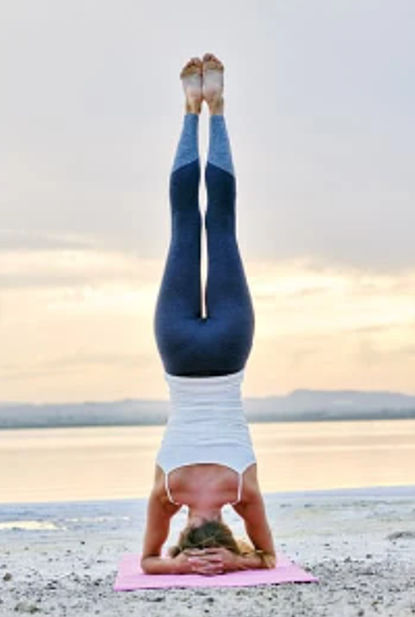Introduction
Hatha Yoga is one of the oldest and most widely practiced styles of yoga, known for its focus on physical postures (asanas), breath control (pranayama) and meditation.
The word “Hatha” translates to “force” in Sanskrit, symbolizing the union of opposites—ha (sun) and tha (moon).
It emphasizes balancing these dual energies within the body, creating harmony between the mind, body, and spirit.
Hatha Yoga is ideal for beginners as it involves slower-paced movements and holding postures for longer durations, allowing practitioners to build strength, flexibility and mindfulness.

Steps to Perform Hatha Yoga
- Begin with Warm-Up: Before diving into the postures, it’s essential to warm up your body. Start with gentle stretches or sun salutations (Surya Namaskar) to activate your muscles and joints.
- Standing Poses: Hatha Yoga often starts with foundational standing postures like Tadasana (Mountain Pose), Virabhadrasana (Warrior Pose), and Utkatasana (Chair Pose). These poses build strength in your legs, improve balance, and enhance focus.
- Seated Poses: Transition into seated asanas like Sukhasana (Easy Pose) or Padmasana (Lotus Pose). These poses promote a steady posture and help cultivate calmness. Paschimottanasana (Seated Forward Bend) is also commonly practiced to stretch the spine and hamstrings.
- Backbends and Twists: Incorporate backbending postures like Bhujangasana (Cobra Pose) or Ustrasana (Camel Pose) to open the chest and stretch the spine. Add gentle twists like Ardha Matsyendrasana (Half Lord of the Fishes Pose) to detoxify the body and improve digestion.
- Balancing Poses: Practicing balancing postures such as Vrksasana (Tree Pose) helps improve concentration, body coordination, and muscle control. Balancing poses challenge your stability and build core strength.
- Pranayama (Breath Control): Hatha Yoga places strong emphasis on breath regulation. You can practice pranayama techniques like Nadi Shodhana (Alternate Nostril Breathing) or Kapalabhati (Skull Shining Breath) to purify the body, calm the mind, and enhance energy flow.
- Meditation and Relaxation: Finish your session with meditation and relaxation. Savasana (Corpse Pose) is the most common way to conclude a Hatha Yoga practice. In Savasana, lie flat on your back with your arms by your side, close your eyes, and focus on deep, slow breathing. Let your body relax completely, absorbing the benefits of your practice.
Benefits of Hatha Yoga
- Increases Strength and Flexibility: One of the most noticeable benefits of Hatha Yoga is improved physical strength and flexibility. The slow, deliberate movements in the practice allow muscles to stretch and strengthen progressively over time.
- Improves Mental Clarity and Focus: The combination of asanas, pranayama, and meditation in Hatha Yoga brings a heightened sense of mental clarity. It improves focus, enhances cognitive function, and sharpens awareness.
- Reduces Stress and Anxiety: Hatha Yoga is highly effective in reducing stress and calming the mind. The practice of deep breathing helps activate the parasympathetic nervous system, which reduces the production of stress hormones and promotes relaxation.
- Boosts Circulation and Detoxification: The various twisting, stretching, and bending postures in Hatha Yoga improve blood circulation, stimulate the lymphatic system, and help in detoxification. This helps in nourishing the organs and flushing out toxins from the body.
- Balances the Nervous System: The practice of Hatha Yoga harmonizes the sympathetic and parasympathetic nervous systems, leading to balanced energy levels. By syncing breath with movement, the practice helps regulate the nervous system and calm the mind.
- Promotes Better Sleep: Regular practice of same Yoga improves sleep patterns by reducing insomnia and other sleep disorders. The relaxation and meditation techniques in Hatha Yoga ease tension, leading to a more restful sleep.
- Supports Weight Loss: While Hatha Yoga may be slower-paced compared to more vigorous forms of yoga, it still aids in weight management. Holding postures builds muscle, and regular practice can increase metabolic function and burn calories.
Precautions and Contraindications for Hatha Yoga
- Consultation for Health Conditions: If you have any chronic medical conditions such as heart disease, arthritis, or respiratory problems, it’s essential to consult your doctor before starting Hatha Yoga. Certain postures may need to be modified to suit your condition.
- Pregnancy Modifications: Pregnant women can practice Hatha Yoga but must avoid poses that compress the abdomen or involve lying flat on the back. Modifications, such as using props or avoiding inversions, should be adopted during pregnancy.
- Avoid Pushing Beyond Limits: Hatha Yoga is about balance and mindfulness, so it’s crucial to listen to your body and avoid overstretching or forcing your way into poses. Practice within your own limits to prevent injury.
- Start with a Certified Instructor: If you’re new to this Yoga, it’s advisable to start with a certified yoga instructor to ensure you’re performing the poses correctly and safely. Incorrect alignment in postures can lead to injury over time.
- Breathing Considerations: While pranayama is beneficial, certain breath control techniques like Kapalabhati or Bhastrika (Bellows Breath) may not be suitable for individuals with high blood pressure or heart conditions. Always practice these techniques under guidance.
Conclusion
- This Yoga is a holistic approach to physical and mental well-being, combining the power of asanas, pranayama and meditation.
- Its slow, deliberate pace makes it accessible for practitioners of all ages and fitness levels.
- Through regular practice, This Yoga helps to cultivate balance, strength, and inner peace, supporting overall health and wellness.
- Whether you’re looking to improve flexibility, reduce stress, or achieve mental clarity, Same Yoga offers a path toward a healthier, more mindful life.
- Its benefits extend far beyond the physical body, nourishing the mind and soul and bringing harmony to every aspect of your being.
